As a woman in my early thirties, I looked forward to menopause because it spelled the end of period cramps for me. In my mid-fifties, however, I realized that menopause was not the heaven I had imagined. No one had prepared me for hot flashes, sleep problems, and mood changes that come with menopause. I was constantly frustrated until I discovered the acupressure points for menopause.
To give a background of menopause, it is a normal condition in the life cycle of a woman. You’ll know you’ve hit menopause when you haven’t seen your period for a straight 12 months, and you are neither pregnant nor sick. Menopause happens to women as they age. For some, it comes early, and for some, it comes much later.
In the United States, the average age for menopause is 51 years. However, statistics show that about 1 percent of women begin menopause before the age of 40, while about 5 percent begin theirs within the ages of 40 and 45.
Menopause comes with uncomfortable symptoms like hot flashes, vaginal dryness, sleep disorders, mood changes, chills, and thinning hair. And because it is a natural occurrence, you can only adjust your lifestyle or undergo hormone therapy to manage the symptoms of menopause.
A less stressful and more effective method of managing menopause is through acupressure, and in this article, I’ll show you the pressure points for menopause that you should stimulate for quick relief of menopausal symptoms.
Can Acupuncture Help Menopause Symptoms?

Yes, acupuncture is a very effective therapy in relieving the symptoms of menopause. More women who are dissatisfied by the results of hormone therapy are switching to acupressure for menopause, and there are reasons for this.
A 2003 study supports the use of acupuncture therapy to bring relief to menopausal symptoms like hot flushes, sleep disturbance, and mood changes. The study which was carried out on two groups, found that the mean monthly hot flush severity for the participants decreased after the administration of acupuncture therapy. This result was the same for sleep disturbances and mood changes. In the third month of the study, there was a wide difference in the improvement of the mood between the experimental acupuncture treatment group and the comparison acupuncture treatment group.
A more recent study investigated the efficacy of standardized brief acupuncture in relieving moderate-to-severe menopausal symptoms. This 2018 study experimented on 70 women with moderate-to-severe menopausal symptoms, and the result was tremendous. During the first six weeks of the intervention, these women showed a relevant reduction in their menopausal symptoms without any side effects.
Where Are The Acupuncture Points For Menopause?
The acupuncture points for menopause are located in several meridians, including the kidney, spleen, and bladder. The effectiveness of massaging the pressure points for menopause depends on the menopausal symptoms you’re seeking relief for.
So, in this article, we’re sharing the effective acupressure points to calm frustration and reduce hot flashes, insomnia, palpitation, and cold feet in women experiencing menopause.
Below are the acupressure points for menopause to stimulate for quick relief of menopausal symptoms.
The Acupressure Points For Calming Frustration
Acupoint: EM-29 (Other Names: Shi Xuan)
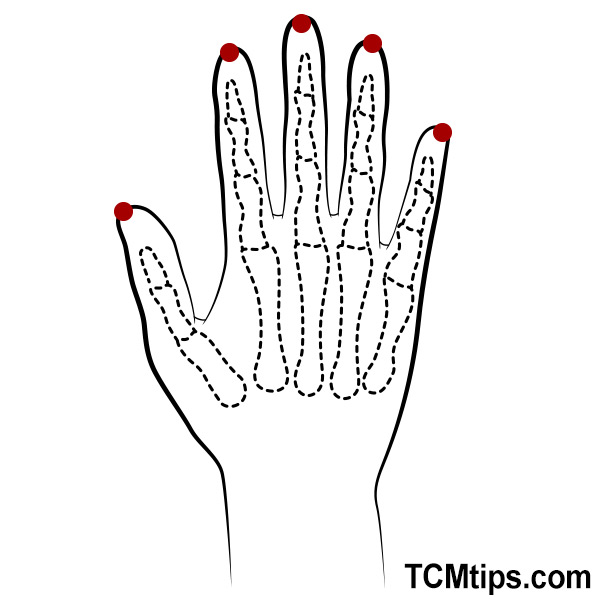
To calm the frustration that comes with menopause, you need to stimulate EM-29. This is an extra acupoint that is located on the hands. As the name implies, Ten Dispersions or Shixuan, as it is called in Chinese, is located at the tips of the ten fingers.
In Traditional Chinese Medicine (TCM), the function of EM-29 is to regulate the autonomic nerves. This is why it is suitable for calming frustration and hot flashes that arise as a result of menopause. Clinically, EM-29 is also used to treat coma, high fever, and epilepsy. All you need do is stimulate the acupoints by raising the nail of the other finger one after the other.
The Acupressure Points For Hot Flashes, Insomnia, and Palpitation
Acupoint: KI-1 (Other Names: Kidney-1/Yong Quan/Gushing Spring)
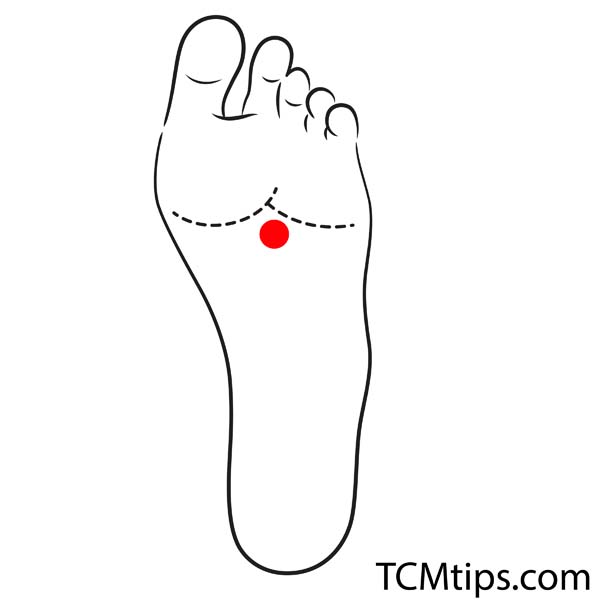
Acupoint KI-1 or Yongquan is one of the acupressure points for menopause that relieves hot flashes, insomnia, and palpitation. It is located on the foot. To locate this point, scrunch your toes. The depression between the second and third toes one-third of the way down your foot is KI-1.
In TCM, KI-1 is responsible for resuscitation, clearing of heat, and calming of Shen. This makes the acupoint effective in reviving consciousness, treating headaches, manic psychosis, constipation, and hot sensations in the soles of your feet. KI-1 is also one of the pressure points to increase energy.
You can stimulate KI-1 by placing the pad of your thumb in the acupoint and rubbing hard for two minutes.
Acupoint: PC-8 (Other Names: Pericardium-8/Lao Gong/Palace of Toil)
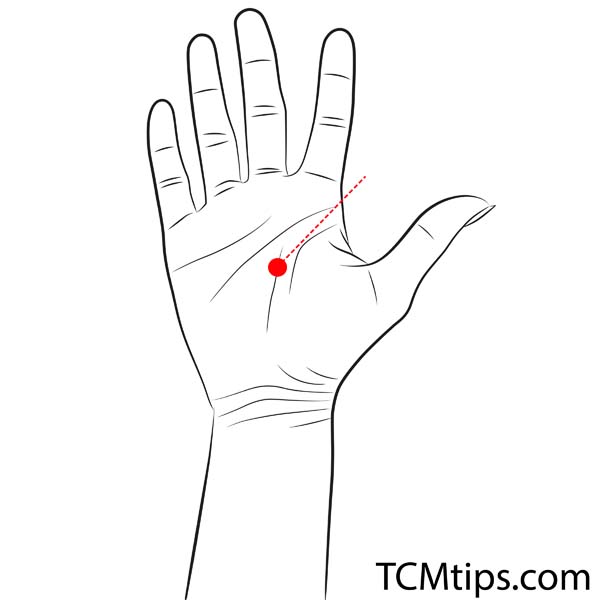
The next acupressure point for menopause relating to hot flashes, insomnia, and palpitation is PC-8. In Chinese PC-8 is referred to as Laogong, which means Labor Palace. However, the pressure point is located in the hand. You’ll find it in the middle of the palm, between the bones of the second and third fingers.
In TCM, PC-8 helps in clearing the heat in the heart as well as calming the Shen. These functions of PC-8 make it suitable for treating mouth ulcers, halitosis, and fungal infection of the hand. It is one of the acupressure points for sleep in hand.
To unlock the healing benefits of PC-8, locate the acupoint, then apply moderate pressure in tiny circles using the tip of your thumb. Do this for a minute.
Acupoint: SP-10 (Other Names: Spleen-10/Xue Hai/Sea of Blood)
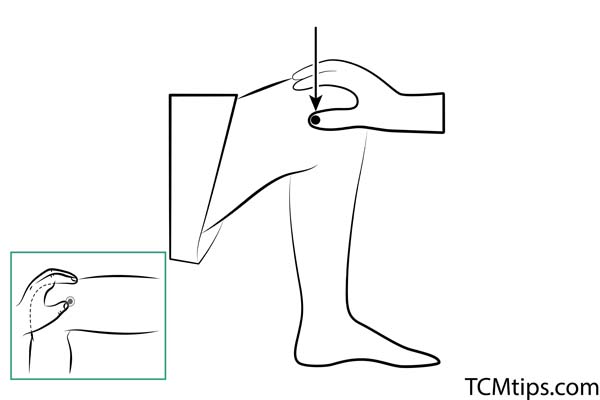
Xuehai or SP-10 is another of the menopause pressure points to consider to relieve you of hot flashes. It is a spleen meridian pressure point that is located in the legs. To locate Xuehai, flex your knee and place your palm on your kneecap such that your fingers are resting on your thighs. The point where your index finger rests is SP-10.
In TCM, SP-10 is the acupoint responsible for treating disorders that relate to the blood. In the case of menopause, blood circulation disorder as a result of the hormonal imbalance that comes with menopause causes hot flashes.
Other clinical use of SP-10 includes the treatment of irregular menstruation, eczema, and urticaria. SP-10 is also an acupressure point for white patches. All you need to do to unlock the healing power of SP-10 is locate the acupoint and push it deeply with your finger until you feel pain.
The Acupressure Points For Cold Feet
Acupoint: Ren-4 (Other Names: The Conception Vessel-4/Guan Yuan/Origin Pass)
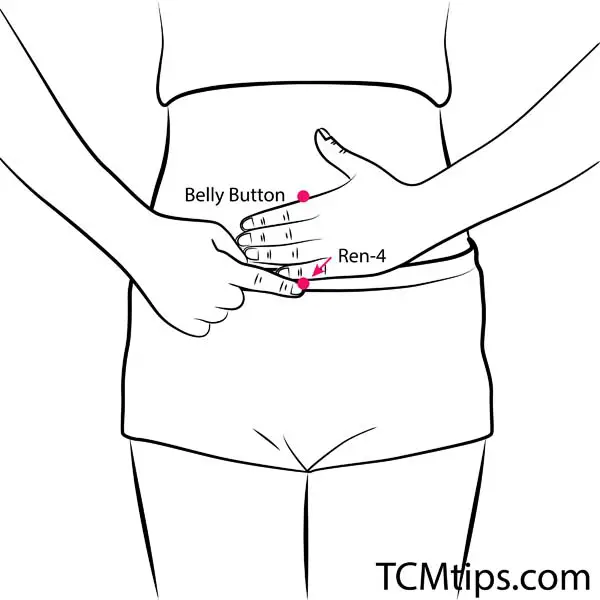
The next menopause pressure point, Ren-4, is for cold feet. Ren-4 or Guanyuan is located in the lower abdomen. To locate this acupoint, take a sitting position and place four fingers below your navel. The point where the pinkie finger rests, on the same line as the navel, is Ren-4.
In TCM, Ren-4 is responsible for strengthening and nourishing the kidney, calming the Shen, and improving menstruation. Hence, it is used clinically to treat irregular menstruation, postpartum hemorrhage, diarrhea, and dyspepsia. Ren-4 is also the right acupoint for acupressure for bloating.
To stimulate Ren-4, locate the pressure point, replace your pinky finger with your middle finger, and press down in a clockwise motion for two minutes.
Acupoint: Bl-23 (Other Names: Urinary Bladder-23/Shen Shu/Kidney Transporter)
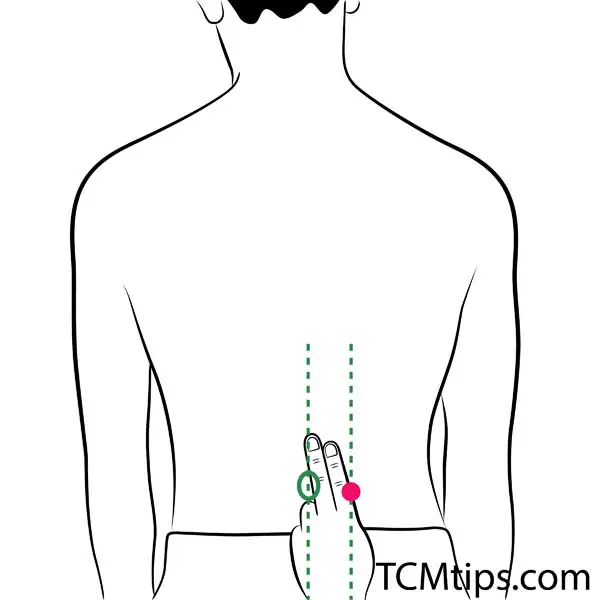
The last of the acupressure points for menopause is Bl-23 or Shenshu. Bl-23 is a urinary bladder pressure point that is located at the lower back. The best way to locate it is to place a finger at the end of your ribcage and trace it to your back, two-finger width from your spine.
In TCM, Bl-23 helps to strengthen the kidney and the lower back, as well as resolve dampness. It is for this reason that it is used to treat edema, irregular menstruation, bone diseases, and lumbar pain. You can also use Bl-23 as one of the acupressure points for back pain due to gas.
To stimulate Bl-23, locate the acupoint with your middle or index finger and apply pressure in a circular motion for two minutes.

Try our Anti-Aging Gua Sha Tool designed to bring out your skin’s natural glow.
Best Gua Sha Product- Anti-Aging: The tool is designed to target 11 specific aging signs such as wrinkles and sagging skin. By following the 7-step routine, users can improve skin firmness and reduce fine lines naturally.
- Enhances Skincare Routine: It works effectively with serums and lotions, boosting absorption and efficacy of skincare products.
- Visible Skin Improvement: Users can expect a smoother complexion, reduced puffiness, and a more youthful appearance.
 P. Sze
P. Sze 
















